小学英语动词讲解及练习
小学英语be动词的用法总结及练习题
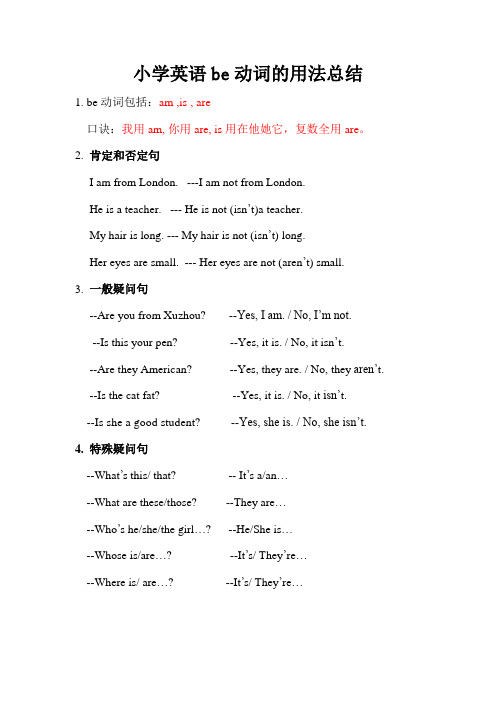
小学英语be动词的用法总结1. be动词包括:am ,is , are口诀:我用am, 你用are, is用在他她它,复数全用are。
2. 肯定和否定句I am from London. ---I am not from London.He is a teacher. --- He is not (isn’t)a teacher.My hair is long. --- My hair is not (isn’t) long.Her eyes are small. --- Her eyes are not (aren’t) small.3. 一般疑问句--Are you from Xuzhou? --Yes, I am. / No, I’m not.--Is this your pen? --Yes, it is. / No, it isn’t.--Are they American? --Yes, they are. / No, they aren’t. --Is the cat fat? --Yes, it is. / No, it isn’t.--Is she a good student? --Yes, she is. / No, she isn’t.4. 特殊疑问句--What’s this/ that? -- It’s a/an…--What are these/those? --They are…--Who’s he/she/the girl…? --He/She is…--Whose is/are…? --It’s/ They’re…--Where is/ are…? --It’s/ They’re…小学英语be动词练习一、用恰当的be动词填空1. I ______ a boy. ______ you a boy? No, I _____ not.2. ______ David and Helen from England?3. The dog _______ tall and fat.4. You, he and I ______ from China.5. ______ your brother in the classroom?6. --Where _____ your mother? --She ______ at home.7. How _______ your father?8. Mike and Liu Tao ______ at school.9. Whose dress ______ this?10. Whose socks ______ they?11. Here _____ a cake for you.12. Here ______ some oranges for you.二、句型转换1. Our school is beautiful.否定句:______________________________________ 一般疑问句:__________________________________ 2. The bike is behind the tree.否定句:______________________________________ 一般疑问句:__________________________________ 对划线部分提问:__________________________。
小学英语动词讲解及练习题

小学英语动词讲解及练习题动词的定义动词是表示人、物或动作状态的词语。
它可以表示行为动作、存在状态、感觉和思维等。
动词的分类1. 行为动词:表示人或物体的具体动作或行为。
例如:run (跑)、eat(吃)。
2. 助动词:用于帮助其他动词构成时态、语态等。
例如:be (是)、do(做)。
3. 不及物动词:没有宾语,只有主语和谓语。
例如:sleep (睡觉)、run(跑)。
4. 及物动词:必须有宾语才能构成完整的意思。
例如:buy (买)、eat(吃)。
动词的练题1. 选择合适的动词形式填空:- My friends __________ basketball every weekend. (play/plays) - The cat __________ on the chair. (sleep/sleeps)- Tom and Mary __________ swimming in the river. (go/goes)2. 填上合适的动词:- My parents _________ (cook) delicious meals every day.- The baby ___________ (cry) because he is hungry.- We _________ (watch) a movie last night.参考答案1. 选择合适的动词形式填空:- My friends play basketball every weekend.play basketball every weekend.- The cat sleeps on the chair.sleeps on the chair.- Tom and Mary go swimming in the river.go swimming in the river.2. 填上合适的动词:- My parents cook delicious meals every day.cook delicious meals every day.- The baby cries because he is hungry.cries because he is hungry.- We watched a movie last night.。
完整版)小学be动词专项讲解及练习

完整版)小学be动词专项讲解及练习Be动词Be动词是英语语法中的基础,包括am、is和are。
它的含义为“是”或“在”。
使用口诀:Be动词真伟大,生出am、is、are。
我用am,你用are,XXX连接他、她、它。
单数名词用is,复数名词全用are。
变疑问,往前提,句末问号莫丢弃。
变否定,更容易,be后not 莫忘记。
疑问否定任你变,句首大写莫迟疑。
肯定和否定句:I am (not) XXX.He is (not) a XXX.She is (not) in the dining room.Her XXX (not) small.一般疑问句:Am I Chinese。
Yes。
you are。
No。
you aren’t.Is the cat fat。
Yes。
it is。
No。
it isn’t.Are they American。
Yes。
they are。
No。
they aren’t.练:1.What is your name。
My name is Tom.2.What is his name。
His name is Kevin.3.What is your mom’s name。
Her name is XXX.4.This is Jim。
my teacher。
That is my sister.5.How are you。
I am fine.6.How is he。
He is OK.7.How is Nancy。
She is fine。
too.8.Where are you from。
I am from Beijing.9.Where is he from。
He is from Canada.10.Where are they from。
They are from England.11.Where is your mom from。
She is from Shanghai.12.Where is his teacher from。
小学情态动词的句型转换讲解及练习

小学情态动词的句型转换讲解及练习情态动词是英语语法中的一个重要组成部分,是文章中用于表达推测、猜测、建议等含义的动词。
小学阶段是英语语言研究的重要时期,因此了解情态动词的正确使用十分必要。
什么是情态动词情态动词是一种助动词,常常用于表示某种能力、必要性、愿望、推测等情况。
动词本身表示的是动作或状态,而情态动词则表示说话人的态度或语气。
常见的情态动词有:- can- could- may- might- must- shall- should- will- would情态动词的句型转换在句子中,情态动词的位置可以变化,因此我们可以利用这一点来进行句型的转换。
以下是一些常见的情态动词句型转换:1. 直述句→ 疑问句直述句:They can swim.疑问句:Can they swim?2. 直述句→ 否定句直述句:He should finish his homework.否定句:He should not finish his homework.3. 直述句→ 疑问句+否定句直述句:You may eat the cake.疑问句+否定句:May you not eat the cake?现在我们来做一些练,更好地掌握情态动词的句型转换。
练题1. 直述句:They can play the guitar.疑问句:否定句:2. 直述句:She should go to bed early.疑问句+否定句:3. 直述句:I will finish my homework tomorrow.否定句:疑问句+否定句:练答案1. 直述句:They can play the guitar.疑问句:Can they play the guitar?否定句:They cannot play the guitar.2. 直述句:She should go to bed early.疑问句+否定句:Shouldn't she go to bed early?3. 直述句:I will finish my homework tomorrow.否定句:I will not finish my homework tomorrow.疑问句+否定句:Won't I finish my homework tomorrow?以上是小学情态动词的句型转换讲解及练习,希望能对您有所帮助。
小学英语情态动词知识点及练习

情态动词【知识要点】:情态动词(Modal verbs)本身有一定的词义, 表示语气的单词。
但是不能独立作谓语, 只能和动词原形一起构成谓语。
情态动词用在行为动词前, 表示说话人对这一动作或状态的看法或主观设想。
情态动词虽然数量不多, 但用途广泛, 主要有下列: can (could), may (might), must, need, ought to, dare (dared), shall (should), will (would) must not.情态动词无人称和数的变化, 情态动词后面跟的动词须用原形, 否定式构成是在情态动词后面加 "not"。
疑问形式是将情态动词提至主语前。
个别情态动词有现在式和过去式两种形式, 过去式用来表达更加客气, 委婉的语气, 时态性不强, 可用于过去, 现在或将来。
情态动词属非及物动词, 故没有被动语态。
【典型例题】:【专题一】:can和could的用法【例1】Can you lift this heavy box?(体力)【解析】表示能力(体力、知识、技能)【练习】1.Mary speak three languages.(知识)2... yo.skate?(技能)此时可用be able to代替。
Can只有一般现在时和一般过去式;而be able to 则有更多的时态。
I’ll not be able to come this afternoon.当表示“经过努力才得以做成功某事”时应用be able to,不能用Can。
【例2】-----Can I go now?----.Yes.yo.can..No.yo.can’t.【解析】表示请求和允许。
此时可与may互换。
在疑问句中还可用could,might 代替,不是过去式,只是语气更委婉,不能用于肯定句和答语中。
【练习】---- I come to see you tomorrow?---.Yes.yo.....----No.yo..../I’.afrai.not.【例3】Can this be true?【解析】表示推测(惊讶、怀疑、不相信的态度),用于疑问句、否定句和感叹句中。
小学英语语法复习动词时态专项讲解和练习
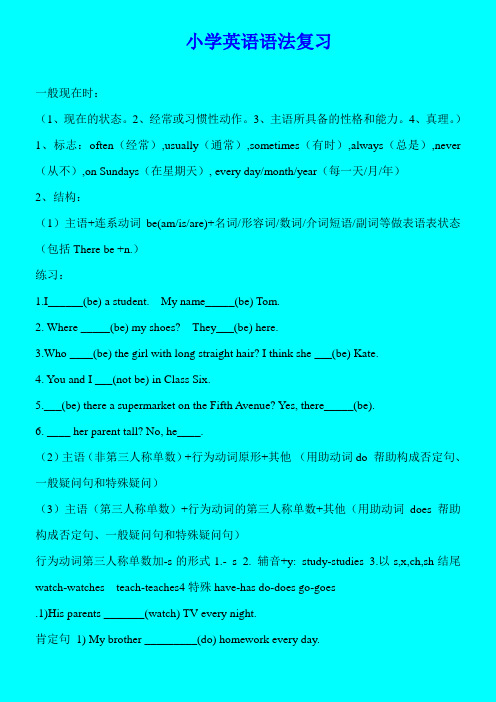
小学英语语法复习一般现在时:(1、现在的状态。
2、经常或习惯性动作。
3、主语所具备的性格和能力。
4、真理。
)1、标志:often(经常),usually(通常),sometimes(有时),always(总是),never (从不),on Sundays(在星期天), every day/month/year(每一天/月/年)2、结构:(1)主语+连系动词be(am/is/are)+名词/形容词/数词/介词短语/副词等做表语表状态(包括There be +n.)练习:1.I______(be) a student. My name_____(be) Tom.2. Where _____(be) my shoes? They___(be) here.3.Who ____(be) the girl with long straight hair? I think she ___(be) Kate.4. You and I ___(not be) in Class Six.5.___(be) there a supermarket on the Fifth Avenue? Yes, there_____(be).6. ____ her parent tall? No, he____.(2)主语(非第三人称单数)+行为动词原形+其他(用助动词do 帮助构成否定句、一般疑问句和特殊疑问)(3)主语(第三人称单数)+行为动词的第三人称单数+其他(用助动词does 帮助构成否定句、一般疑问句和特殊疑问句)行为动词第三人称单数加-s的形式1.- s 2. 辅音+y: study-studies 3.以s,x,ch,sh结尾watch-watches teach-teaches4特殊have-has do-does go-goes.1)His parents _______(watch) TV every night.2)His parents _________(not watch) every night.否定句2)My brother________(not do)homework every day.3)_____his parents_____(watch) TV every night?一般疑3)______ your brother _____ homework every day?Yes, they _______. No, they _______.Yes, he______. No, he _________.4)When___ his parents _____(watch) TV?特疑4)When _____ your brother ____(do) homework?5)They watch TV every night.He does homework every day.二.现在进行时:表示说话瞬间或现阶段正在进行的动作。
小学英语动词知识点及练习题
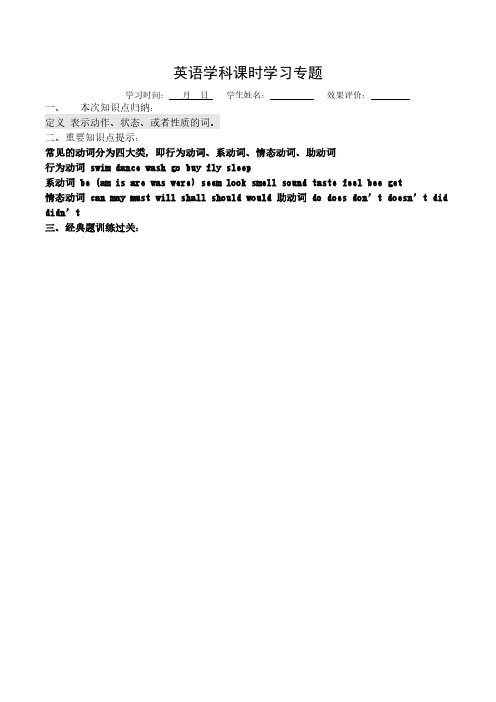
英语学科课时学习专题学习时间:月日学生姓名:效果评价:一、本次知识点归纳:定义表示动作、状态、或者性质的词。
二、重要知识点提示:常见的动词分为四大类,即行为动词、系动词、情态动词、助动词行为动词 swim dance wash go buy fly sleep系动词 be (am is are was were) seem look smell sound taste feel bee get情态动词 can may must will shall should would 助动词do does don’t doesn’t did didn’t三、经典题训练过关:将下面各组词组成句子。
(12分)1._____________________________? (you ,can ,hear me)2. ____________________________ (not,he ,dance,can )3.____________________________? (you,can ,see,what )4.____________________________(can ,see ,not ,we ,you)5._____________________________. (I ,can ,help ,you )6._____________________________? (I,can ,do,what)一)选择填空:(56分)1. My brother ____ a teacher. He ____ his pupils very much.A. is, likeB. is, likesC. are, likesD. are, like2. A: How many days ____ there in a week?B: There ____ seven.A. is, isB. are, areC. is, areD. are, is3. I ____ tired last night.A. becameB. feltC. lookedD. am4. Her face ____ pale(苍白)when she heard the bad news.A. gotB. isC. turnedD. was5. You ____ pale. What's wrong with you?A. turnB. seemC. lookD. bee6. The boy ____ ill today.A. areB. isC. beD. am7. Which ____ bigger, the sun or the moon?A. areB. isC. beD. ×8. Neither she nor I ____ a doctor.A. am notB. amC. areD. is9. I ____ a worker next year.A. amB. will beC. beD. will10. Her voice ____ like my mother's.A. soundsB. soundC. looksD. look11. It often rains and the crops ____ fast.A. getB. turnC. growD. bee12. A: How are you ____ now?B: Much better, thank you.A. gettingB. feelingC. makingD. turning13. The teacher's smile made me ____ better.A. feelB. to feelC. feelingD. felt14. My English teacher ____.A. all look youngB. looks youngC. look youngD. all looks young15. I ____ busy now, but I ____ free next week.A. am, amB. am, willC. am, will beD. being, will be16. I ____ at this school for about two months.A. amB. will beC. have beenD. was17. My brother ____ in the League(社团) for about five years.A. have beenB. has beenC. wasD. is18. e to my office if you ____ free tomorrow.A. areB. will beC. wasD. is19. If water ____ heated(加热), it will be ____ into vapour (蒸气).A. was, turnedB. is, turnedC. is. getD. was, got20. If you don't take back what you just said, Mother ____ angry.A. isB. will beC. getD. feels21. Neither of us ____ a doctor.A. amB. areC. isD. were22. He ____ a famous writer.A. turnsB. beeC. has beeD. has turned23. The girl's face ____ red.A. turnedB. gotC. feelD. look24. He ____ very glad.A. lookedB. turnedC. feelD. looks25. The flowers ____ fragrant (芳香).A. getB. smellsC. smellD. feels26. The table ____ very smooth(光滑的).A. lookB. turnC. feelsD. smell27. Jack ____ younger than Tom.A. lookB. feelC. feelsD. looks28. She looks ____.A. happyB. to be happyC. happilyD. that she is happy(二)把下列各句译成英语:(16分)1.天色渐黑,咱们回家吧。
小学英语情态动词can,should的用法总结及练习题

小学英语情态动词can,should的用法总结及练习题
一、can (过去式could)
1) 表示能力(体力、知识、技能)
Can you lift this heavy box?
Mary can speak three languages.
Can you skate?
2) 表示请求和允许
--Can I go now?
-- Yes, you can. / No, you can’t.
3) 表示客观可能性(客观原因形成的能力)
They’ve changed the timetable, so we can go by bus instead.
This hall can hold 500 people at least.
4) 表示推测(惊讶、怀疑、不相信的态度),用于疑问句、否定句和感叹句中。
Can this be true?
How can this be true?
二、should
1) 表示劝告、建议和命令,译为“应该”。
I should help her because she is in trouble.
You should go to school right away.
Should I open the window?
2) 表示推测
should(客观推测,“可能”), must (主观推测,“一定”)。
He must be home. (断定他在家)
He should be home.(不太肯定)。
最新小学英语语法be动词讲解及练习
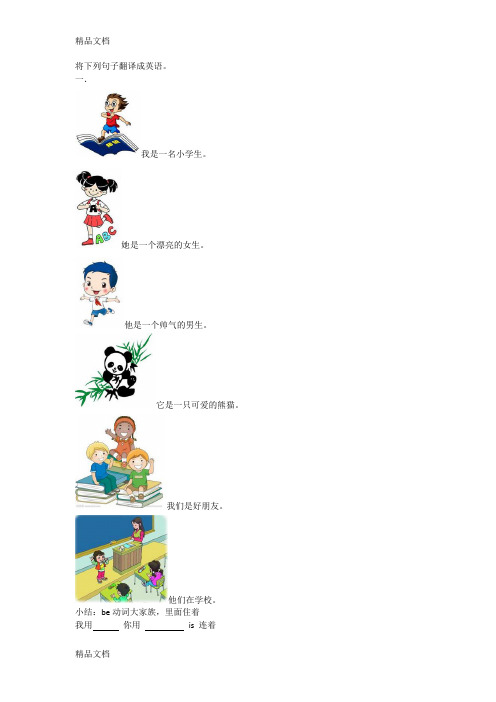
将下列句子翻译成英语。
一.我是一名小学生。
她是一个漂亮的女生。
他是一个帅气的男生。
它是一只可爱的熊猫。
我们是好朋友。
他们在学校。
小结:be动词大家族,里面住着我用你用is 连着单数复数写出下列形式的缩写。
I am you are he is she is it is we are练习1. 我在家。
2. 我很开心。
她是我妈妈。
他正在读书。
我们在五年级一班。
它是一件连衣裙。
它是红色的。
提升练习我妈妈是一名厨师。
我爸爸是一名医生。
我姐姐十二岁。
二.There be 句型中be动词的单复数。
1. There a desk in the room.2.There three children in the room.3.There some books and a cup on the desk.4.There a cup and some books on the desk.There four people in my family.三.句型变换。
1.变否定句He is a teacher.She is at home.We are in the same school.I am tall.2.将上述句子变一般疑问句,并作肯定回答和否定回答。
3.特殊疑问句这是什么?哪本是你的书?谁是我们的英语老师?这是谁的铅笔盒?你好吗?你的爸爸还好吗?你的周末过得好吗?你哥哥在哪?她为什么迟到?你的生日是什么时候?What time is it?What day is it?What’s the date today?Where are you from?他来自哪里?她叫什么名字?练习: 用be动词(is, am, are)的适当形式填空:1.I a boy. you a boy?2.The girl Jack’s sister.3.your brother in the classroom?4.Where your mother?5.How your father?6.Mike and Liu Tao at school.7.That my red skirt.8.Who I ?9.How old your teacher?10.There seven days in a week.11.There some water in the bottle.12.There a pen and two books on the desk.13.There some pencils and a ruler in the pencil case. 根据图片提示回答问题。
小学英语情态动词讲解和练习

Can I use your pen? Yes, here it is. Can you help me? Yes, I can.
我能用一下你的钢笔吗? 当然,给你。 你能帮帮我吗? 是的,当然。
Did you know? When you put not after can, you write it as one word: cannot. Learn these contractions: cannot= can’t Some birds cannot(can’t )fly.
2. 表示可能性时,常用在肯定句中,意为“可能,也许” He may be very busy now. 他现在可能很忙。 He said that she may not be at work today. 他说她今天也许不上班。
3. Can 和 may 都可以表示推测。can 通常用在否定句和疑问句中,may 通常用在肯定句和否定句中。 虽然两者都可以用于否定句,但是程度不同,can’t 的语气比may not 更强。
A. can B. may C. must
II. Read and write.
1. You _____c__a__n_________ (can) borrow my book, if you want. 2. They’ve lost the map and ___c__a__n___n___o__t__ (can) find their way back to the hotel. 3. May I go out to play now? No, you ___m___a___y___n__o__t________(may). 4. If you want to be healthy, you __m___u___s__t__n___o__t_____ (must) eat junk food. 5. You ___m___u___s__t__________ (must) believe yourself.
小学英语语法be动词讲解及练习
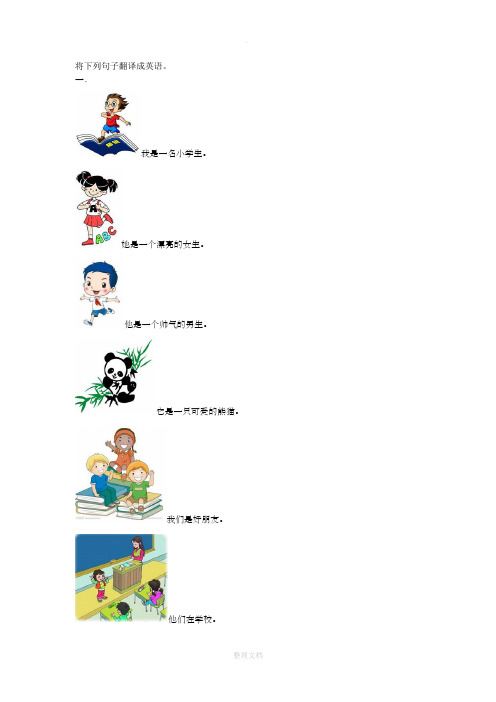
将下列句子翻译成英语。
一.我是一名小学生。
她是一个漂亮的女生。
他是一个帅气的男生。
它是一只可爱的熊猫。
我们是好朋友。
他们在学校。
小结:be动词大家族,里面住着我用你用is 连着单数复数写出下列形式的缩写。
I am you are he is she is it is we are练习1. 我在家。
2. 我很开心。
她是我妈妈。
他正在读书。
我们在五年级一班。
它是一件连衣裙。
它是红色的。
提升练习我妈妈是一名厨师。
我爸爸是一名医生。
我姐姐十二岁。
二.There be 句型中be动词的单复数。
1. There a desk in the room.2.There three children in the room.3.There some books and a cup on the desk.4.There a cup and some books on the desk.There four people in my family.三.句型变换。
1.变否定句He is a teacher.She is at home.We are in the same school.I am tall.2.将上述句子变一般疑问句,并作肯定回答和否定回答。
3.特殊疑问句这是什么?哪本是你的书?谁是我们的英语老师?这是谁的铅笔盒?你好吗?你的爸爸还好吗?你的周末过得好吗?你哥哥在哪?她为什么迟到?你的生日是什么时候?What time is it?What day is it?What’s the date today?Where are you from?他来自哪里?她叫什么名字?练习: 用be动词(is, am, are)的适当形式填空:1.I a boy. you a boy?2.The girl Jack’s sister.3.your brother in the classroom?4.Where your mother?5.How your father?6.Mike and Liu Tao at school.7.That my red skirt.8.Who I ?9.How old your teacher?10.There seven days in a week.11.There some water in the bottle.12.There a pen and two books on the desk.13.There some pencils and a ruler in the pencil case.根据图片提示回答问题。
小学英语语法详解精练 8 句子的脊梁—动词
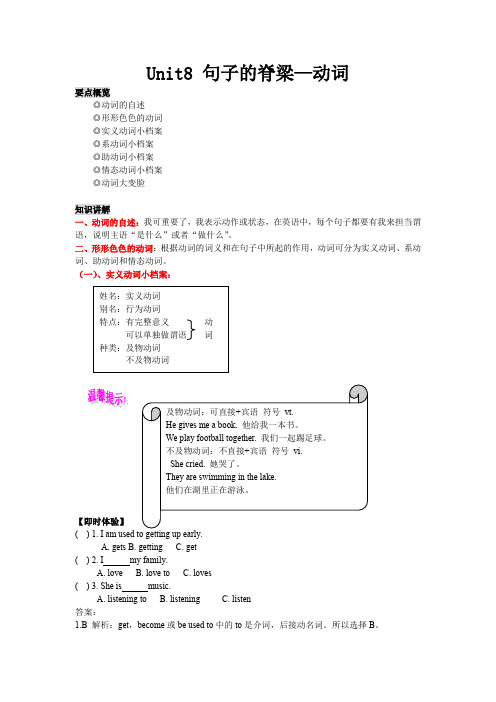
Unit8 句子的脊梁—动词要点概览◎动词的自述 ◎形形色色的动词 ◎实义动词小档案 ◎系动词小档案 ◎助动词小档案 ◎情态动词小档案 ◎动词大变脸知识讲解一、动词的自述:我可重要了,我表示动作或状态,在英语中,每个句子都要有我来担当谓语,说明主语“是什么”或者“做什么”。
二、形形色色的动词:根据动词的词义和在句子中所起的作用,动词可分为实义动词、系动词、助动词和情态动词。
(一)、实义动词小档案:【即时体验】( ) 1. I am used to getting up early. A. gets B. getting C. get ( ) 2. I my family.A. loveB. love toC. loves ( ) 3. She is music.A. listening toB. listeningC. listen 答案:1.B 解析:get ,become 或be used to 中的to 是介词,后接动名词。
所以选择B 。
2.A 解析:love 是及物动词,及物动词直接加宾语,又因为I是第一人称,及物动词不用加s,所以选择A。
3.A 解析:listening是不及物动词,不及物动词不能直接加宾语所以选择A。
(二)、系动词小档案【即时体验】( ) 1. Her face pale(苍白) when she heard the bad news.A. gotB. isC. turned( ) 2. He very glad.A. lookedB. turnedC. looks( ) 3. The flowers fragrant(芳香)。
A. getB. smellC. become答案:1. C 解析:根据句意可以知道当听到坏消息时她的脸变得苍白,脸苍白是有转变的过程,所以选择C。
2. C 解析:这三个都是表示状态的系动词,但是只有C和句子的时态一致。
3. B 解析:这是考察get smell become这三个系动词的意思,get:become都是变成的意思,smell 是闻起来的意思,根据句意可选B。
小学英语be动词用法详解及练习

小学英语be动词用法详解及练习{ be动词的用法}语法专题详解1、be动词包括am,is,are三个词。
2、Am、is、are这三个词常在一般现在时中出现,我们可以将其用法归纳如下:am、is用于主语表单数概念的句中(主语是you除外)。
第一人称单数I配合am来用,常见句型“I am+…”;第三人称单数He、She 、It配合is使用,常见句型“She/He/It is +…”如:I am ten years old.I am a boy.She is a good girl.He is so thin.It is a dog. 它是一只狗。
Are主要用于主语表复数概念的句中Are主要用于主语表复数概念的句中(包括一些简单集体名词,如:people,family),第二人称(You)配合are使用,常见句型:“You are+…”如:You are great.Amy and Mary are sisters.苏海和苏洋是姐妹。
The family are all at home.全家人都在家。
There are many apples on the tree. 树上有很多苹果。
代词you是一个单复数同形词,既可表示“你”,又可表示“你们”,所以避免混淆,总是跟are 做朋友。
注意:含有be动词的句子的否定是在把not放在be动词的后面。
如:I am not a student. 我不是学生。
The cat isn’t white.这只猫不是白色的。
They aren’t students.他们不是学生。
常见的简缩形式的变法1、简缩形式的变法:把倒数第二个字母,通常是元音字母变成' 但are除外,are要把a打成' 。
Eg:I am=I’m he is=he's they are=they'reshe is=she’s we are=we’re it is=it’s2、简缩形式和完全形式的汉语意思相同。
小学英语语法be动词讲解及练习

精品文档将下列句子翻译成英语。
一.我是一名小学生。
她是一个漂亮的女生。
他是一个帅气的男生。
它是一只可爱的熊猫。
我们是好朋友。
他们在学校。
小结:be动词大家族,里面住着我用你用is 连着精品文档单数复数写出下列形式的缩写。
I am you are he is she is it iswe are练习1. 我在家。
2. 我很开心。
她是我妈妈。
他正在读书。
我们在五年级一班。
它是一件连衣裙。
它是红色的。
提升练习我妈妈是一名厨师。
我爸爸是一名医生。
我姐姐十二岁。
二.There be 句型中be动词的单复数。
1. There a desk in the room.2.There three children in the room.3.There some books and a cup on the desk.4.There a cup and some books on the desk.There four people in my family.三.句型变换。
1.变否定句He is a teacher.She is at home.We are in the same school.I am tall.2.将上述句子变一般疑问句,并作肯定回答和否定回答。
3.特殊疑问句这是什么?哪本是你的书?谁是我们的英语老师?这是谁的铅笔盒?你好吗?你的爸爸还好吗?你的周末过得好吗?你哥哥在哪?她为什么迟到?你的生日是什么时候?What time is it?What day is it?What’s the date today?Where are you from?他来自哪里?她叫什么名字?练习: 用be动词(is, am, are)的适当形式填空:1.I a boy. you a boy?2.The girl Jack’s sister.3.your brother in the classroom?4.Where your mother?5.How your father?6.Mike and Liu Tao at school.7.That my red skirt.8.Who I ?9.How old your teacher?10.There seven days in a week.11.There some water in the bottle.12.There a pen and two books on the desk.13.There some pencils and a ruler in the pencil case. 根据图片提示回答问题。
小学英语-Be动词的用法总结及专项练习知识讲解
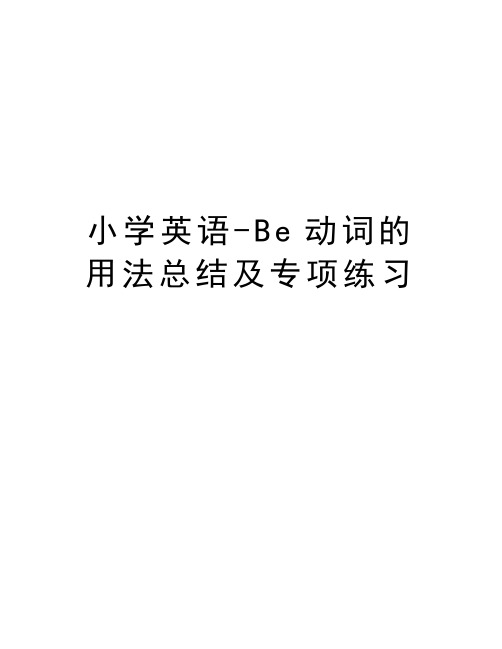
小学英语-B e动词的用法总结及专项练习星光教育暑期班英语内部资料一.Be动词的用法总结及专项练习Be动词的用法口诀 :be动词am\is\are,我(I)用am,你(you)用are,is连着他(he),她(she),它(it);单数名词用is,复数名词全用are。
我们(we)你们(you)和他们(they)都用are;过去式am\is变was,are变 were;变疑问,往前提,句末问号莫丢弃。
变否定,更容易,be后not莫忘记。
疑问否定任你变,句首大写莫迟疑。
二、Be动词专项练习题(一.)用be动词的适当形式填空。
1. I ________ from Australia.2. She _______ an English student.3.Mike and Tom _________ my friends.4. My parents _______ very busy every day.6.I ______ an English teacher now.7.Where _________ you from?10.The light _________ green.11.My name _________ Li Lei. I _________ twelve.12._______they your new friends?13. I ______ a boy. ______you a boy? No, I _____ not.14. The girl______ Jack's sister.15. The dog _______ tall and fat.16. ______ your brother in the classroom yesterday?17. Where _____ your mother? She ______at home.18. Whose dress ______ this?19.That ______ my red skirt.20.Who ______ I?21. Some tea ______ in the glass.22.Jhon ______ busy last weekend..23. My sister's name ______Nancy.24. This ______ not Wang Fang's pencil.25. ______ David and Helen from England?26. We ____ friends.27. She ___ a teacher.28. I ___ a girl.29. Many ants ____ in my house.30.His mother ____ fat.(二.)写出下列词适当形式:1.I am (缩略形式) ______2.is (复数)______3.we are (缩略形式) ______4.are not(缩略形式) ______5.is not (缩略形式) ______6.is/am(过去式形式) ______7.she's(完整形式) ______ 8.it's(完整形式) ______9.they're(完整形式) ______ 10.are(过去式形式) ______(三. )将下列句子变成否定句和一般疑问句,再作肯定和否定回答。
小学四年级常用动词汇总及句型练习

小学四年级常用动词汇总及句型练习一、常用动词汇总在小学四年级学习英语的过程中,掌握常用动词是非常重要的。
以下是一些常用动词的汇总,供同学们参考和学习:1. be(是,存在)2. have(有)3. do(做)4. go(去)5. play(玩)6. eat(吃)7. drink(喝)8. read(读)9. write(写)10. study(学习)11. sing(唱)12. dance(跳舞)13. draw(画)14. listen(听)15. speak(说话)16. run(跑)17. jump(跳)18. walk(走)19. sleep(睡觉)20. wake up(醒来)二、句型练习1. be动词句型:I am a student.我是一个学生。
She is my sister.她是我的姐姐。
2. have动词句型:We have a pet dog.我们有一只宠物狗。
He has a red pencil.他有一支红色铅笔。
3. do动词句型:They do homework every day.他们每天做作业。
I do housework on weekends.我在周末做家务。
4. go动词句型:We go to school by bus.我们坐公交车去学校。
He goes to the park with his friends.他和他的朋友们去公园。
5. play动词句型:They play basketball in the afternoon.他们在下午打篮球。
She plays the piano very well.她弹钢琴弹得很好。
6. eat动词句型:I eat breakfast at 7 o'clock.我七点吃早饭。
They eat fruit after dinner.他们晚饭后吃水果。
7. drink动词句型:We drink water when we are thirsty.我们口渴的时候喝水。
小学英语语法专项练习-动词讲解及练习题

小学英语语法专项练习-动词讲解及练习题一、动词的概念动词是表示人、事物的动作、状态或存在的词,是英语句子中最核心的部分。
二、动词的分类1. 及物动词:需要加宾语才能构成句子的动词,例如:write、eat等。
2. 不及物动词:不需要加宾语也可以构成句子的动词,例如:laugh、sit等。
3. 助动词:辅助主要动词构成各种时态、语态和否定式,例如:be、do等。
三、动词时态动词时态表示动作发生的时间,常用的动词时态有以下几种:1. 一般现在时:表示现在正在发生的事情或经常性的动作。
2. 一般过去时:表示过去发生的动作或状态。
3. 一般将来时:表示将要发生的动作或状态。
4. 现在进行时:表示现在正在进行的动作或状态。
5. 过去进行时:表示过去某个时刻正在进行的动作或状态。
6. 将来进行时:表示将来某个时刻正在进行的动作或状态。
四、动词的练题1. 用所给动词的正确形式填空:1) He often ____(play) football with his friends after school.2) My father ____(be) a doctor when he was young.3) They ____(visit) the museum tomorrow morning.4) She ____(watch) TV now.2. 根据括号内的提示写出动词正确的形式:1) He usually ____(drink) milk in the morning. (一般现在时)2) We ____(cook) dinner at six o'clock last night. (一般过去时)3) Tomorrow we ____(go) to the park to have a picnic. (一般将来时)4) Look! The boy ____(swim) in the river. (现在进行时)以上是小学英语语法专项练习-动词讲解及练习题,希望有所帮助!。
- 1、下载文档前请自行甄别文档内容的完整性,平台不提供额外的编辑、内容补充、找答案等附加服务。
- 2、"仅部分预览"的文档,不可在线预览部分如存在完整性等问题,可反馈申请退款(可完整预览的文档不适用该条件!)。
- 3、如文档侵犯您的权益,请联系客服反馈,我们会尽快为您处理(人工客服工作时间:9:00-18:30)。
第四课时语法知识词法(3)
五、动词
这里所说的动词是指各种动词总称,其中包括be动词、情态动词、助动词、行为动词(就是我们平时总说的那种动词)。
动词、名词和形容词不太容易区分,如不能一眼看出,可用如下方法:先用“一(量词)”(如:一个、一张等)和这个词连起来说,如说得通,一般认为是名词;说不通再用“很”去判断,就是把“很”和为个词连起来说,说得通一般就是形容词;都说不通就是动词。
(目前我们学过的,以后可能不同)
1、be动词( am, is, are, )
1)am—was, is –was, are--were 口诀:我用am, 你用are, is 用在他她它,所有复数全用are。
2)肯定和否定句 I am (not) from London. He is(not) a teacher.
She is(not) in the dining room. My hair is(not) long. Her eyes are(not) small.
3)一般疑问句Am I a Chinese Yes, you are. No, you aren’t.
Are they American Yes, they are. No, they
aren’t.
Is the cat fat Yes, it is. No, it isn’t.
4)be动词的否定形式:am not(没有缩写形式),are not = aren’t ,is not = isn’t 。
2、助动词( do, does, )
do, does用于一般现在时,它们通常用在疑问句和否定句中。
它们的否定形式:do not = don’t, does not = doesn’t, did not = didn’t。
注意:在一般现在时中,does用于第三人称单数,其余一律用助动词do;助动词do, does,后面一定要用动词原形。
3、情态动词
情态动词也是一类特殊的动词,平时我们不把它说成是动词。
情态动词可以和行为动词同时出现在同一个句子中。
我们现在学过的情态动词有:can、could、shall、should、will、would、may、
注意:情态动词后动词总是用原形。
(不受其他任何条件影响)
其否定形式:can not = can’t, must not = mustn’t, …注
意:may not和shall not(无缩写形式)
4、行为动词
就是我们平时上课时说的动词,表示某一动作或行为。
如:sweep、live等。
行为动词我们已学过它们的四种形式:原形、第三人称单数+s/es、现在分词(也叫动名词)+ing、
(1)动词原形
情态动词 + 动词原形 help+动词原形助动词+动词原形
have to+动词原形 Shall we +动词原形祈使句动词原形开头
want +to++动词原形 how +to++动词原形 would like +to++动词原形
Would you like + to+动原 be happy +to++动词原形 Let +宾格+动词原形
It’s time +to+动词原形can’t wait to+动词原形
(2)动词第三人称单数变化规则:
A、一般直接加“s”,如:play –plays, visit –visits, speak
– speaks ;
B、以“s”,“x”,“sh”,“ch”结尾时,加“es”,如:catch – catches, watch – watches ;
C、以“辅音字母+y”结尾时,变“y”为“i”再加“es”,如:carry – carries, study – studies 。
(3)现在分词(动名词)构成规则:
A、一般直接加“ing”,如:go – going, do – doing, look –looking ;
B、以不发音的“e”结尾的单词,去“e” 加“ing”,如:take –taking, make – making, have – having ;
C、以重读闭音节结尾的词,如末尾只有一个辅音字母,需要双写这个字母再加“ing”,如:
put –putting, stop –stopping, run –running, get –getting, swim – swimming, sit – sitting, begin – beginning, forget – forgetting 。
be+动词ing no+动词ing go+动词
ing
like+动词ing love+动词ing start+
动词ing
begin++动词ing stop+动词ing
how about/What about+动词ing be good at+动词in 不是祈使句,放在句子开头的动词要加ing
练一练:
一、用be动词的适当形式填空
1. What __________ you doing here
2. Jimmy _________ absent from school last Monday.
3. There _________ a lot of people here yesterday.
4. We _________ going to give her the key tomorrow
.
5. Smith and I __________ at the barber’s last ni ght.
6. There _________ a tree, a tiver, and many flowe rs on the picture.
7. That pair of shoes______ (be) new.
二、用适当的助动词填空。
1) ______you like this magazine
2) ---What ______ she ______ at the weekends ---She usually plays games with her friends.
3) ---What______ you do last Sunday ---I wrote to my friend.
4) ---Did you see a Beijing opera ---No, I ______.
三、用动词的适当形式填空。
(1)I ______to school from Monday to Friday. My brother often _______to school with me. We like ________to school very much. ( go )
(2)They usually _______lunch at home. ( have )
(3)My sister likes ________very much. She often _______at our school festival. She _____beautifully. ( sing )(4)What _____ he usually ______on Sunday He usually ______his homework. Look! He __________his homework now. ( do )
(5)Do people usually_______ moon cakes at Mid-autumn Festival Yes, they do. Do you like _______moon cakes Yes, I do. ( eat )
(6) I want ______ apples.(pick)
四、写出下列动词的现在分词。
put __________ give __________ fly _________
get ________ dance ________ sit_________ run ________ take ___________ swim _________ ask ___________ stop __________ take _________。
